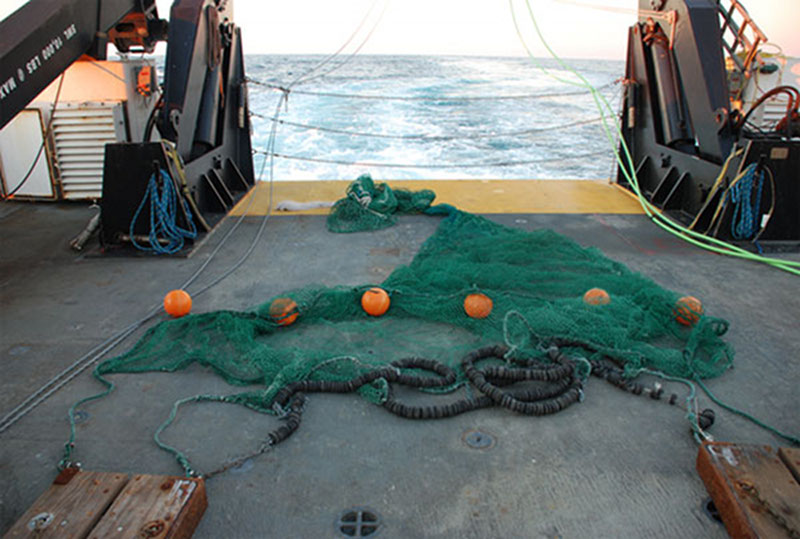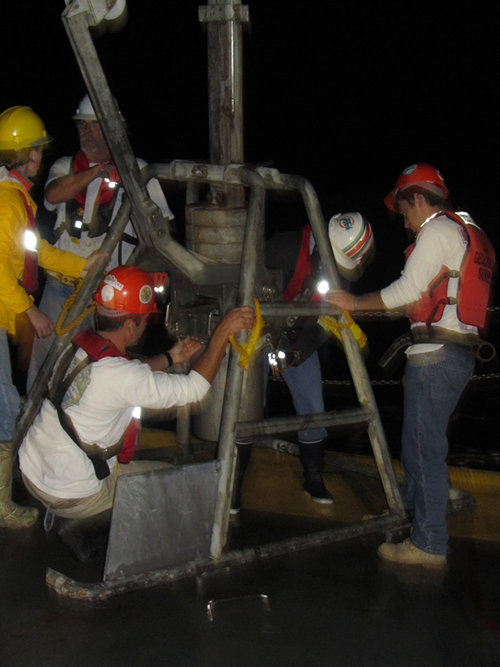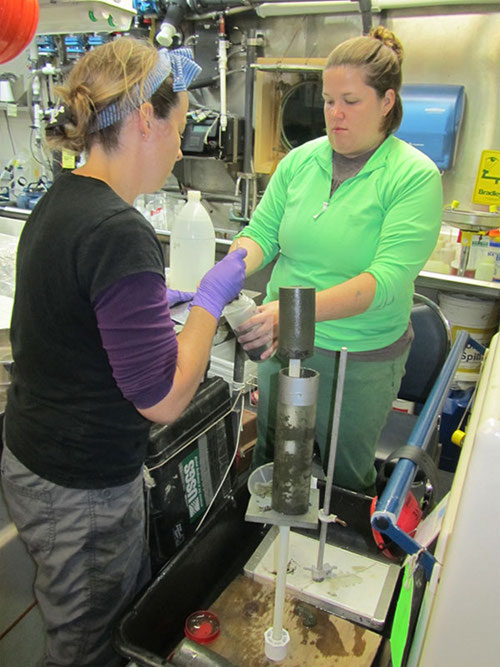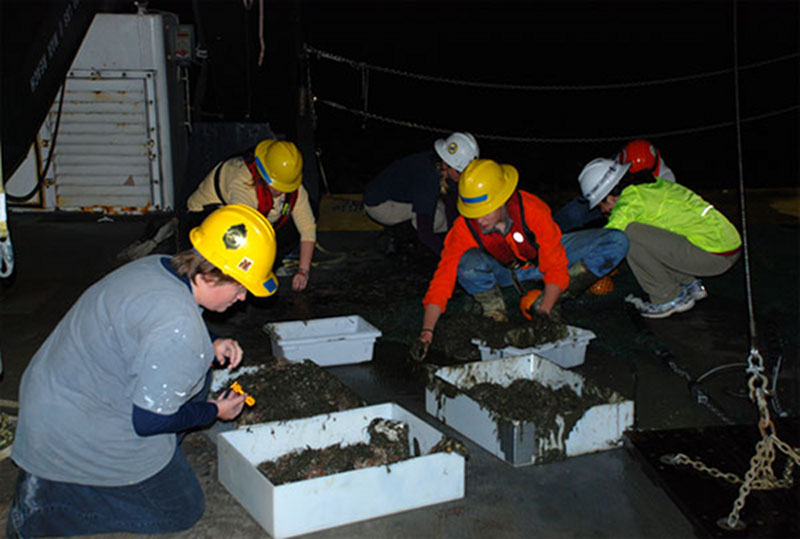
By Amanda Demopoulos - U.S. Geological Survey
September 25, 2012

Trawl on deck and ready to go for night trawling operations. Image courtesy of Deepwater Canyons 2012 Expedition, NOAA-OER/BOEM. Download image (jpg, 100 KB).
We have had a very successful Leg 3, examining shipwrecks and canyon biology in Norfolk Canyon. For me, our productive sampling in Norfolk Canyon directly complements Leg 1 studies in Baltimore Canyon, facilitating direct comparisons of the benthic communities found between canyons.
I am fascinated by creatures living in the mud, virtually unseen by the human eye. These sediment fauna, or infauna, represent a significant part of the diversity, biomass, and food webs of canyon environments.

Ship crew and science crew work together to bring heavy sampling devices, onboard safely, whether it is this loaded box core, the ROV, CTDs, or trawl nets. Cooperation and care is essential for both safety of the crew and equipment and viability of the samples. Image courtesy of Deepwater Canyons 2012 Expedition, NOAA-OER/BOEM. Download image (jpg, 69 KB).
To sample the benthos, I am collaborating with colleagues from the Royal Netherlands Institute for Sea Research (NIOZ), Drs. Furu Mienis and Gerard Duineveld, who provided the box corer to collect quantitative sediment samples. While Dr. Mienis will analyze the cores for sediment chemistry and geological parameters, Craig Robertson and I are focused on the small, almost invisible animals that live within the mud.
Given that microbes are important, yet unappreciated, components of deep-sea environments, Dr. Chris Kellogg from the U.S. Geological Survey subsampled the sediments to characterize the associated microbial communities.

Specimens from the trawl sorted and assigned a carbon isotope vial and number – waiting for final preparation from the scientists. Image courtesy of Deepwater Canyons 2012 Expedition, NOAA-OER/BOEM. Download image (jpg, 71 KB).
Larger invertebrates and fish collected by trawling the canyon floor have given us a window into the diversity and ecology of these hard to observe fauna and Drs. Steve Ross and Sandra Brooke will work towards identifying these animals. Analysis of the core samples and trawls will tell us who is living in, on, and above the sediments (from microbes to megafauna), and by analyzing tissue samples collected from these animals for stable carbon and nitrogen isotopes, we will develop a food-web model for canyon ecosystems.
Data collected from the benthic landers and moorings will help us understand particle transport within the canyons, including the abundance of nutritious algae, representing an important food source, which can influence the types of organisms living in and on the sediments. By sampling down the canyon axis along a depth gradient, we will ascertain whether there is a pattern in faunal and microbial distribution and diversity with depth and between canyons.

Principle Investigator, Amanda Demopoulos, pushing smaller cores into the mud retrieved from the bottom. (Note the smile! Dr. D. loves the mud!) Image courtesy of Deepwater Canyons 2012 Expedition, NOAA-OER/BOEM. Download image (jpg, 66 KB).

Amanda Demopoulos and Espirit Saucier in the wet lab carefully measuring and removing layers of the smaller core sampling into separate containers for later analysis. Image courtesy of Deepwater Canyons 2012 Expedition, NOAA-OER/BOEM. Download image (jpg, 89 KB).
The success of this multifaceted project is a direct result of careful coordination by scientists from different disciplines (physical, chemical, geological, biological) using tools and techniques and integrating data that will lead to improved understanding of canyon processes and their influence on the benthos. Our analyses are only just beginning, but by working together, this research will yield a comprehensive understanding of the structure and function of canyon environments.

Science crew sorting the trawl catch. This very successful catch, which came in around 2 AM, was still not completely sorted and processed by 9:30 AM. Image courtesy of Deepwater Canyons 2012 Expedition, NOAA-OER/BOEM. Download image (jpg, 77 KB).